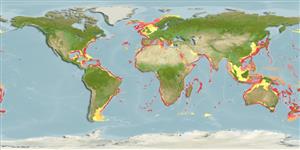Common names from other countries
Пластиножаберные (акулы и скаты) (sharks and rays) >
Echinorhiniformes (Bramble sharks) >
Echinorhinidae (Bramble sharks)
Etymology: Echinorhinus: echinos (Gr.), spiny or sea urchin, referring to thorn-like denticles (brambles) on body; rhinus, an ancient name for sharks, from rhine (Gr.), rasp, alluding to a shark’s jagged, rasp-like skin. (See ETYFish); brucus: Latin for caterpillar, presumably referring to “Chenille” or “Chenille de mer” (Sea Caterpillar), local names for this shark along the Atlantic Coast of France (type locality) in the 18th century. (See ETYFish).
More on author: Bonnaterre.
Environment: milieu / climate zone / depth range / distribution range
экология
морской батидемерсальный; пределы глубины 10 - 900 m (Ref. 27121), usually 350 - 900 m (Ref. 45445). Deep-water; 72°N - 55°S, 98°W - 173°W (Ref. 54427)
Western Atlantic: Virginia, Massachusetts, USA; Venezuela, Argentina. Eastern Atlantic: North Sea to Mediterranean, Morocco to Cape of Good Hope, South Africa. Indian Ocean: India, Mozambique, South Africa. Western Pacific: Japan, southern Australia, New Zealand. Records from Oman and Kiribati uncertain. Apparently absent in the Eastern Pacific (Ref. 6578).
Length at first maturity / Size / Вес / Возраст
Maturity: Lm ?, range 200 - ? cm
Max length : 310 cm TL самец/пол неопределен; (Ref. 247); common length : 200 cm TL самец/пол неопределен; (Ref. 26999)
колючие лучи спинного плавника (общее число) : 0; колючие лучи анального плавника: 0. The bramble shark Echinorhinus brucus has thorn-like denticles on body which are very large (single denticles up to about 15mm in basal diameter in adults), sparse irregularly distributed and thorn-like with smooth basal margins, some bases fused into compound plates. Dorsal surface dark purplish-grey to brown with white denticles, ventral surface paler; sides and back may have dark spots. Tooth count 20-26/21-26.As with the other member of the family Echinorhinidae, it has a relatively short snout and stout body; two small spineless dorsal fins, close together, towards posterior part of body and originating behind pelvic fin origin. No anal fin and subterminal notch on caudal fin. Small spiracles, very short labial furrows and teeth on both jaws alike, with a central oblique bladelike cusps with up to 3 cusplets on each side (absent in juveniles) (Ref. 247, 6871, 5578).
A rare (Ref. 26346), large, sluggish, deepwater shark found on continental and insular shelves and upper slopes (Ref. 247). Sometimes found in shallow water (Ref. 247). Feeds on smaller sharks, bony fishes, and crabs (Ref. 247). Ovoviviparous (Ref. 205), with 15-26 young in a litter (26346). Never recorded as attacking people. Sometimes hooked by shore anglers (Ref. 5578). Processed into fishmeal. May be used in traditional medicine in southern Africa (Ref. 5578).
Ovoviviparous. 15 to 26 young in a litter (Ref. 26346). Size at birth between 29 and 90 cm. Distinct pairing with embrace (Ref. 205). Size at maturity unknown but adult males of 150 cm and adult females of 213 cm have been reported (Ref. 6871).
Compagno, L.J.V., 1984. FAO Species Catalogue. Vol. 4. Sharks of the world. An annotated and illustrated catalogue of shark species known to date. Part 1 - Hexanchiformes to Lamniformes. FAO Fish. Synop. 125(4/1):1-249. Rome, FAO. (Ref. 247)
Статус Красного Списка МСОП (Ref. 130435)
CITES (Ref. 128078)
Not Evaluated
Использование человеком
рыболовство: не имеет хозяйственного значения; объект спортивного рыболовства: да
дополнительная информация
инструменты
Специальные отчеты
Скачать в формате XML
ресурсы в Интернет
Estimates based on models
Preferred temperature (Ref.
115969): 4.1 - 13.9, mean 8.5 (based on 1524 cells).
Phylogenetic diversity index (Ref.
82804): PD
50 = 1.0000 [Uniqueness, from 0.5 = low to 2.0 = high].
Bayesian length-weight: a=0.00363 (0.00139 - 0.00949), b=3.13 (2.90 - 3.36), in cm Total Length, based on LWR estimates for this (Sub)family-body shape (Ref.
93245).
Trophic level (Ref.
69278): 4.4 ±0.7 se; based on diet studies.
устойчивость к внешним воздействиям (Ref.
120179): очень низкий, минимальное время удвоения популяции более 14 лет (Fec= 15-24).
Fishing Vulnerability (Ref.
59153): Very high vulnerability (90 of 100).
Climate Vulnerability (Ref.
125649): Moderate vulnerability (38 of 100).
